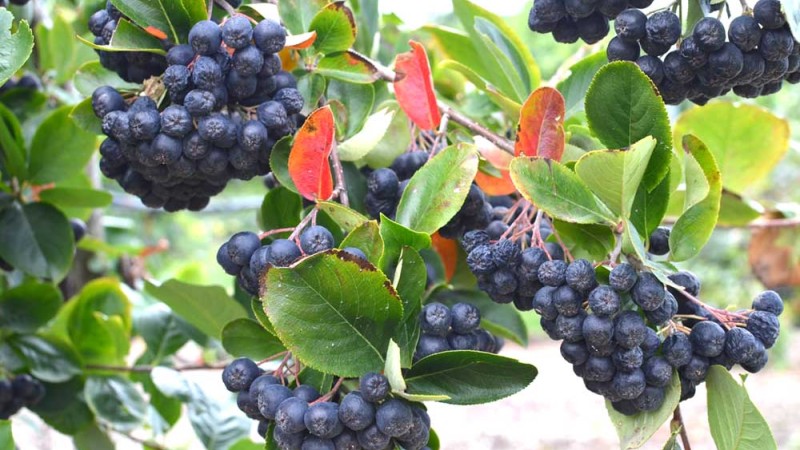
Black chokeberry (Aronia melanocarpa) is a species of shrubs in the rose family native to North America, but is widely cultivated in Europe and Asia for fruit production. It is commercially grown in Russia, Eastern Europe and Poland. The combination of its high antioxidant content, health benefits, versatility in food applications, and relatively easy cultivation makes it a promising and increasingly popular crop for commercial growers.
Adaptability and ease of cultivation
Black chokeberry is easy to grow, thrives in a variety of soil conditions, and tolerates both full sun and partial shade. It is also known for its high frost resistance and resistance to pests and fungal diseases, making it a low-maintenance crop.Plant
Chokeberry plant is a decidious, branching shrub with glossy dark green leaves. In autumn, the shrubs delight with their bright red foliage. Typically grows to a height of 1.5 - 2 m and width of 1.2 - 1.5 m wide. In European climates blooms from mid-May with white flowers in umbels. Due to it’s self pollinating flowers, only one plant is needed for producing fruits. Chokeberry plants start producing fruit in their second or third year after planting. Mature plants can yield up to 10 kg or more of fruit. The full fruit ripeness is reached from mid-August to early September. Depending on the variety, up to 30 berries can form in one umbel. The berries are round, dark purple to almost black, 6 - 13 mm in size. The flesh is crimson red in color and the darker the flesh, the riper the fruit. Berries have a distinctive, tart and astringent taste.
Soil
Chokeberry plants are adaptable and can grow in a variety of soils, but they prefer slightly acidic soil with a pH between 6 and 6.5. They tolerate wet, poorly drained soils in winter and dry summers. Soil preparation for chokeberry plants is very similar to other berries. Involves adding organic matter like aged manure and compost in the fall and again in late winter, tilling it in well. Mulching with organic matter also helps enrich the soil.
Fertilizing and Watering
Chokeberry shrubs generally do not need any supplemental fertilizer, especially if your soil is reasonably fertile. If you choose to fertilize, a balanced, slow-release fertilizer applied in early spring is sufficient. You can also incorporate compost around the base of the plants. Watering your chokeberries is needed for maximum fruit production. When dry, water the plants once or twice a week early morning.
Pruning
Pruning helps maintain the plant's shape, promotes air circulation and sunlight penetration, encourages new growth, and improves fruit production. Pruning is best done in late winter or early spring, before budding. For general maintenance, remove dead, damaged and crossing branches. Remove some of the oldest and thickest branches to open up the center of the shrub. Suckers will develop around the base of the plant. Remove these rooting branches as they appear, to prevent spreading. Rejuvenation pruning is done on old, poorly fruiting shrubs. Cut the oldest branches down to the ground every few years to rejuvenate the plant and encourage new growth.
Fruits and their versatile use in food products
Fresh berries can be stored in the refrigerator for up to four months at 0-2°C. They can also be frozen or dried for longer-term storage. Chokeberries are rich in antioxidants, which offer various health advantages. This has led to its increasing use in the food and health industries. The berries are eating fresh, or processed into various products, including juices, jams, syrups, teas, wines, and even used as a natural food colorant. Their sour-tart taste can be used in cooking or baking.
High Antioxidant Content
Chokeberries are known for having a high concentration of antioxidants, particularly anthocyanins and other polyphenols. These antioxidants play a role in preventing cell damage, potentially reducing the risk of chronic diseases like cancer and heart disease. Research suggests that Aronia melanocarpa may have anti-inflammatory, anticancer, antimicrobial, and antiviral properties. Studies have also explored its potential benefits for hypertension, glucose metabolism, and metabolic syndrome. The increasing interest in functional foods and the anti-aging market is driving demand for Aronia melanocarpa.
There are several varieties of chokeberry suitable for fruit production, each with unique characteristics. The most popular in Europe are the Viking and Nero varieties, known for their vigor and high productivity.









